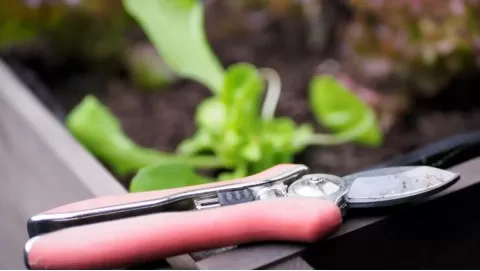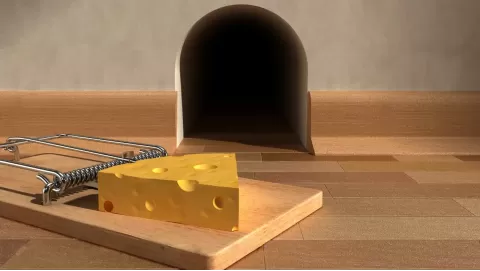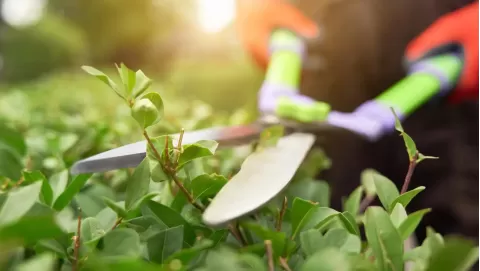
Top tree trimming tools for homeowners: Cut branches like a pro
Many homeowners have trees with overhanging branches. These branches can obstruct the sun, cause damage to the roof or leave the yard looking a mess. Often user need the right tool for the job for cutting branches. A good tree trimmer tool will make the job easier, quicker and safer.
MEET THE EXPERT
- ■ Hans Tielmann is renowned in the tree care industry for leveraging social media to showcase best practices in arboriculture, emphasizing safety and innovation.
- ■ Ethan Tapper formerly Vermont’s Chittenden County forester, Ethan now manages his own 175-acre working forest and shares educational content on tree care.
Safe tree trimming tools are designed to cleanly cut through branches without injuring the tree. Good tools make it possible for homeowners to take down dead, broken or otherwise dangerous branches without either climbing too high or overexerting themselves. It also reduces the risk of accidents through slips or using dull tools, or standing on unstable ladders.
Why the Right Tool Matters
Trees and yards come in all shapes and sizes, so picking the best trimming tool is tough. Some branches are high, some are thick and stout. A small yard might not require much more than a light tool, while a big yard may need tools that reach higher. The best tool to help with a job depends on factors like reach, branch thickness and the strength of the user.
The tool can fail to cut properly if it is too small or weak. This can injure the tree or create rough cuts that don’t heal properly. On the other hand, a tool that’s too heavy or difficult to control can cause accidents and injuries.
The correct tree limb cutter for home use helps make clean and precise cuts, preserves the health of trees and makes the job easier for the individual who is doing the task. Selecting the right tool to fit the yard’s needs saves time, spares the tree and lowers the chance of user injury.
Types of Tree Trimmer Tools
There are a variety of tools to trim trees. Picking out the right type depends on how thick the branches are, how high up they are and how comfortable the user is.
Manual Tools
Hand tools are powered by hand and are best for small to medium branches. They are silent, portable and do not require electricity or batteries. These are fantastic tools for simple tree care in most yards.
1. Pruning Shears (Secateurs)
Pruning shears are small hand scissors specifically built for cutting branches up to ¾ of an inch in diameter. They are ideal for light trimming tasks such as shaping small trees, dead twig cutting, or pruning of shrubs and bushes.
The two primary categories of pruners are:
- Bypass shears function with two overlapping curved blades, like scissors. They produce clean, sharp cuts and are suitable for live, green branches.
- Anvil-pruners possess one sharp blade that closes onto a flat surface, known as the anvil. They’re ideal for cutting dry, dead or hard branches, but can crush live wood.
A certain number of pruning shears also feature ergonomic handles that will lighten the hand strain and make trimming more pleasant, most especially if user is up for a long day’s work.
2. Loppers
Loppers are essentially large pruning shears with long handles, so users can use them to cut thicker branches up to 2 or 3 inches thick. They deliver more cutting force and better reach than a pair of pruning shears.
Loppers come in various forms:
- A special gear system in the center of compound loppers means added cutting power. They are useful to cut the thick or hard wood.
- Ratchet loppers will let the user cut in notches. When release the force of the squeeze, the curved blade lock to hold the blade its position for push cuts through heavy brush.
- Telescopic loppers feature handles that can be extended and shortened. They reach up into the higher branches and avoid climbing a ladder.
Loppers are good for pruning medium-sized trees, taking out dead wood and making clean cuts with minimal exertion.
3. Pruning Saws
A pruning saw is for branches that are too thick for loppers. They are meant for trimming branches thicker than 2 – 3 inches. The blades are sharp, curved and designed to cut quickly and cleanly.
Pruning saws come in several varieties:
- Folding hand saws are lightweight, easy to carry, and safe to store. The blade retracts into the handle when not in use.
- Fixed-blade saws can handle more torque and have more strength. They are not as good with heavier work or for larger branches.
Pruning saws make great tree limb cutter for home use when cutting down small trees or low hanging branches of larger trees.
Electric Tools
Electric tree branch trimmers with engines make for a good option if user has a lot of tree work to do or want to speed and simplify the job. These implements have more force than hand pruners and can slice through thick branches more easily.
1. Corded Electric Pole Saws
Electric pole saws connect to a power cord that plugs into an electric outlet for constant, non-stop power. They’re great for long trims, as there’s no need to recharge.
Benefits
- Excellent for cutting high branches with less effort.
- Powerful performance for big or frequent trimming jobs.
Limitations
- The cord is short or otherwise inconvenient.
- Requires an outdoor outlet or an extension cord.
The best corded electric pole saw for the homeowner who has a good number of tall trees near their house.
2. Battery-Powered Pole Pruners
Cordless pole pruners, powered by a battery, are easier to maneuver around the yard. They are rechargeable and work well for medium jobs.
Benefits
- No cord, so there’s greater freedom of movement.
- Convenient to use in large yards or where power cords are hard to come by.
Limitations
- They don’t have much battery life, with most models running for 30 to 60 minutes.
- Power could be compromised compared to corded models.
Useful for clipping branches in open spaces or when the user can’t reach the area they need to cut.
Extendable Tree Cutter Tools
Extendable tree cutter tools are great for cutting those higher branches without using a ladder. They assist in reaching 10 to 20 feet or more and may be manual or powered. These are ideal tools for tall trees or wide yards.
1. Manual Pole Pruners
Manual pole pruners consist of a long pole with a cutting blade at the end. The person pulls on a rope or cable to cause the blade to snap down on the branch. Some have tiny saws for harvesting thicker branches.
- Rope-pull pruners are designed to be opened and closed using a rope.
- Cable-actuated pruners feature an internal cable mechanism that helps give the pruner a more precise cut.
- Fiberglass poles are durable and highly flexible, as well as easy to use.
- The combo tool contains a blade and a saw in one tool for different size branches.
Manual pole pruners are ideal for occasional trimming and for light to medium branches overhead.
2. Telescopic Loppers and Pole Saws
They have handles or poles that can extend and be locked at varying lengths. They can range from 12 to 20 feet long, depending on the model. Some are equipped with both a shear blade and a saw blade for versatile cutting powers.
- Telescopic pole design for more convenient to use.
- Integrated saw or lopper to cut various kinds of branches.
- Good for pruning hard-to-reach areas without a ladder.
Telescopic models are great for large trees, sloping yards or where ladders can’t be used safely.
Top 5 Tree Trimming Tools for Homeowners
Growcycle has made available a number of best tree trimming tools, all used to cut branches safely even up to tall heights. Here are five great tools that are user-friendly and well-suited to the needs of most homeowners.
1. Fiskars Pruning Stik Extendable Tree Pruner
This little gem is fantastic for high branches which people want to trim without a ladder. The Fiskars Pruning Stik can grow from 7.9 feet to 12 feet. It also has a 230° rotating head, which is ideal for cutting branches at awkward angles, with less need to bend and less strain.
It’s lightweight and maneuverable, which is why it is a favorite for both light trimming and higher limbs.
2. Corona 14-Foot Tree Pruner with Saw
This tree pruner with a saw can reach up to 14 feet, providing extra reach for tall trees. It includes a razor saw for cutting through thick branches and a rope-pulling pruner for trimming smaller ones.
The pulley system includes additional cutting power, so users don’t have to work as much. It’s great for cutting off the dead wood or the crowded top of a tree.
3. Corona 12′ Tree Pruner with Saw
This is a strong, light weight pruner that is 12 inches long and can cut limbs up to a foot thick. It comes with a built-in pruning blade that snips small branches up to 1 inch thick and a 13-inch saw for cutting larger limbs.
It has a fiberglass pole that is heavy and durable, but not so heavy that the user needs to call in a crane to get the blower around the yard. It’s an excellent option for a home version of regular tree maintenance.
4. Corona 10-Inch Folding Pruning Saw with Razortooth Blade
For branches too thick for shears or loppers, this folding pruning saw is a good alternative. A sharp-toothed 10-inch curved blade does the job rapidly and neatly.
Blade folds down into the handle for safe storage and transport. It’s a tool that’s good for trimming medium size branches or cleaning up storm damage.
5. Corona 12-Inch Compound Action Tree Pruner
This pruner is constructed for increased cutting power. It employs a compound-action mechanism that multiplies the force the user applies, enabling the user to easily slice through stubborn or thick branches up to 2 inches wide.
It comes with a 12-inch saw atop a sturdy fiberglass pole for extended reach. A non-stick coating on the blade helps prevent sap from building up and making for easier cleanup.
Step-by-Step Tree Trimming Techniques
Proper pruning of branches on mature trees encourages healing and healthy branches. It also lessens the risk of damage or injury. Here are simple steps that homeowners can follow to make clean, safe cuts.
1. Check the Branches First
Before starting to chop, take a good look at every branch. The dead, damaged, or diseased branches should be pruned before anything else. These are either dry and brittle or have no foliage. It is safer and healthier to get deadwood out sooner.
2. Plan Where to Cut
Do always cut near the “branch collar,” the little raised section where the branch connects to the trunk or a bigger branch. Trimming the tree close to the collar promotes proper healing. Never cut too high or too low off the trunk.
3. Choose the Right Tool
Not to mention that various diameters of branches require different tools:
- Small branches (3/4 of an inch thick and under) can be pruned with pruning shears.
- For medium branches (up to 2 inches thick), the user should use loppers.
- For thicker branches, use a pruning saw.
Preferably by using the right tool which will result in clean cuts and won’t injure the tree or exhaust the person cutting the tree.
4. Make the Right Type of Cut
Slice at a slight angle so that water does not pool on the cut surface. A neat, angled cut is less likely to lead to disease or rot. Do not run the risk of tearing, which the user would introduce if the branch broke before the user completed the cut. For substantial branches, three-cut the branch:
- First, a few inches out from the trunk, cut a small slit just under the branch.
- Then, cut from the top a little farther out to remove most of the branch.
- Then, make the final cut just beyond the branch collar.
5. Clear the Cut Area
Inspect the site where you made the cut after trimming to ensure there are no rough edges or splinters. A clean cut also assists the tree in sealing the wound more rapidly. Do not paint or seal the injury as healthy trees will be able to heal themselves.
Tree Pruning Equipment and Best Practices
Tree trimming can be dangerous if the right safety steps are not followed. Using proper tree pruning equipment and smart working habits helps prevent injuries and accidents.
1. Wear the Right Safety Gear (PPE)
Personal Protective Equipment (PPE) shields the body from cuts, falling limbs and debris from the air. Some of the key items are:
- Gloves: Keep the hands safe from sharp branches, rough bark, and accidental tool slips. Opt for heavy-duty gloves with excellent grip.
- Safety Glasses: Protect the eyes from falling branches, wood chips, or debris when cutting.
- Hard Hat: The head is protected from falling branches, especially when users work under the tree or use the pole tools.
- Tough Shoes: Wear closed-toe shoes or boots with non-slip soles to stay stable and prevent injury.
2. Use Ladders Carefully (or Avoid Them When Possible)
Ladder work during trimming raises the chance of a fall. If a ladder is needed:
- Make sure to set it up on a flat surface.
- Ensure that it is stable before climbing up.
- Never support yourself from one side. Crawl down and reposition in turn.
- Use a helper to hold the ladder if possible.
3. Be Aware of Surroundings
Inspect the surroundings and then:
- Look out for power lines as users get closer to the treetops; never prune if branches are in proximity to a power line.
- Remove anything from the ground, such as garden tools or toys, that could cause a trip.
- Keep people and pets at a safe distance when cutting.
4. Take Breaks and Avoid Overreaching
Tired hands or bad balance can result from working for too long. It’s best to take short breaks and work in smaller sections of time. Do not stretch the arm too much, particularly when using heavy equipment. Just don’t lean out too far to reach, either reposition the ladder or get a longer tool.
5. Check Tools Before Use
Check the tools for any damage before trimming:
- Keep blades sharp and clean.
- Inspect connections to poles.
- Replace broken or frayed ropes or split length handles.
Using well maintained tools makes the work easier and the user is less likely to be injured too.
FAQs
What is the best tool to trim tree branches?
It is according to branch size. If it’s too hard to handle, add more water and a couple more squirts of dish soap, then cut it into smaller pieces with pruning shears or an old pair of garden scissors.
What is the best tree trimming technique?
With angled cuts, cut just beyond the branch collar. First, remove dead branches, and then use the proper tool for a clean, safe trim.
How can I make clean cuts when trimming trees?
For clean, healthy cuts, choose a cutting spot just above a bud or leaf and at a slight angle, and avoid tearing the outer tree bark; for larger branches, use the three-cut method.
The Bottom Line
Homeowners who wish to avoid the dangers posed by dead tree branches and keep their trees healthy need to select the right tree trimmer tool. The correct tool makes clean cuts, contributes to better healing, and reduces the risk of injury. Check out Growcycle for the best tree trimming tools that are simple to use and will last.
Disclaimer: This material is for informational purposes only and should not be relied on for legal, medical, financial, or any other form of professional advice.





















